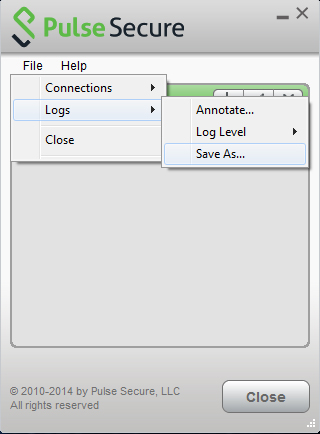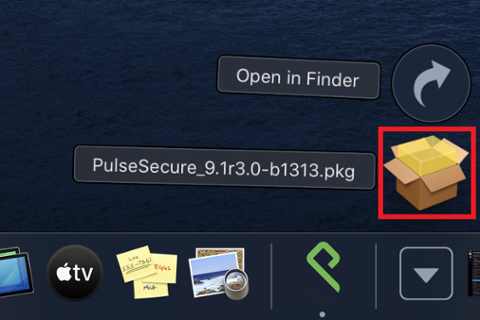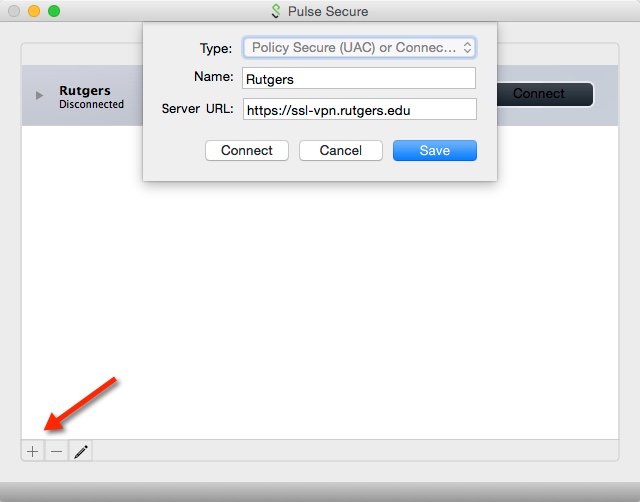This article covers how students, faculty, and staff install the Pulse Secure VPN client on Mac OS X 10.13 or macOS 10.14 and higher.
If you need assistance or if you are not running MacOS 10.13 or higher, submit a support ticket to the Technology Support Center.
In the Search for the Pulse Secure Application Launcher window, click Download. Figure 2: Searching for the Pulse Secure Application Launcher Note: In case you did not click Download, after a minute’s search, the wizard indicates that the Pulse. Install Pulse Secure for MAC — JWU IT. Download the Pulse Secure installer. Open the package file. Click 'Continue' and 'Install.' I've just been sent the email to download the new Pulse Secure client (ps-pulse-mac-5.2r4.1-b787-installer.dmg) when opening the file i get an error. From the Download box (on right), click the Pulse Secure VPN Client Mac OS X file. The Web Login screen will appear. In the Web Login screen, enter your NetID and NetID password. The Pulse Secure Installer will automatically download. Find the Pulse Secure Installer file in your Downloads folder and right click Open on the icon to.
Choose your OS
Mac OS 11 Upgrade
Mac users who upgrade to the latest version of macOS 11 (Big Sur) should uninstall the Pulse Secure client prior to the upgrade and then install the latest version available after the macOS upgrade is complete. Use the 'Simple Removal' instructions on the Removing the Pulse Secure Desktop Client guide.
If you upgrade to macOS 11 (Big Sur) ) with a version of Pulse Secure older than 9.1.9 installed it can cause a Mac running Big Sur to crash and restart 4-5 times before recovering.
- Download the Pulse Secure Desktop client for Mac OS 11.
- Click on the file to extract the installer.
- Double click on the pkg file to initiate the install process.
- Once the installer begins, click Continue.
- Click Install to begin the installation.
You may encounter several popups during and after the install process when attempting to connect to the UConn network.
System Extension AND Network Content Filtering:
This prompt below will pop up after installation (If your Mac is managed by ITS you will not see this pop up).
- Click Ok
- Click the lock in the bottom left corner to make changes (You will be prompted for your user password).
- Click Allow
Filter Network Content:
This prompt will popup during the connection process the first time press Allow; if you do not press Allow the VPN will not work correctly. *If you do not see this prompt, see the below fix.
If you don't press anything or if you press Don't Allow you will soon see this popup:
Press Retry and then press Allow when the popup pictured above re-appears.
*If the 'Filter Network Content' prompt does not appear:

- Quit the Pulse Secure app.
- Navigate to Apple menu > System Preferences > Network
- Select Pulse Secure in the left-hand menu and click the minus button ( - ) to remove it.
- Open the Pulse Secure app again and connect to the VPN. The Filter Network Content prompt shown above should now appear. If it does not, repeat this process and try again.
- Download the Pulse Secure Desktop client for Mac OS.
- Click on the file to extract the installer.
- Double click on the pkg file to initiate the install process.
- Review the following warning, select 'OK'
- Click on the Apple icon in the top-left of your screen. Choose System Preferences > Security & Privacy > General
- Find the warning 'PulseSecure.pkg' was blocked from use because it is not from an identified developer.' Select 'Open Anyway'
- Review the following warning, select 'Open'.
- Run through the installation process.
- Download the Pulse Secure Desktop client for Mac OS X.
- Click on the file to extract the installer.
- Double click on the pkg file to initiate the install process.
- Once the installer begins, click Continue.
- Click Install to begin the installation.
- During the installation process you should expect to see several pop-up messages informing you of security steps that need to be taken to complete the install.
- Click OK on the first two messages.
- Click 'Open Security Preferences' in the third message to open up the 'Security & Privacy' settings window.
- Click OK on the first two messages.
- Once the Security & Privacy window has opened, look for the following message: System software from developer 'Pulse Secure LLC' was blocked from loading.
- Next to the message, click Allow to enable the extension.
If you do not receive the above mentioned pop-up messages, you will need to manually permit the Pulse Secure Client the required access.
If you wait longer than 30 minutes to complete this process, you will need to uninstall and reinstall the client and then follow this process again.- To manually permit access to the client,
- Click the Apple menu at the top left of your desktop.
- Click System Preferences.
- Click Security & Privacy.
- Click the lock to make changes.
- Click the General tab.
- Under Allow apps downloaded from, select App Store and identified developers
- Look for the following message: System software from developer 'Pulse Secure LLC' was blocked from loading.
- Next to the message, click Allow to enable the extension.
- To manually permit access to the client,
- Close the Security & Privacy window. The kernel extension will have been authorized and full functionality of the Pulse Desktop client should be available.
Configuring the Pulse Secure VPN Client after installation is complete
- Open the Pulse Secure client, which should be shown at the top right corner of the screen.
- Create a new connection using the + in the bottom left corner.
- Enter the following info:
- Connection name of your choosing
- The server URL, vpn.uconn.edu
- Click Add.
- Close the client.
- To start the VPN session, go back to the Pulse Secure client in the top right corner of the screen.
- Select the connection you created.
- Select Connect.
- When prompted for a username and password, enter your NetID and NetID password.
- When attempting to connect, you may receive the following prompt. Select 'Open Security Preferences'.
- Within 'Security Preferences', select the lock on the bottom left corner. Once unlocked, select Allow, for the system to allow Pulse Secure to load.
Once you receive this prompt, select Allow to allow Pulse to operate. After this, you should be all set to connect via Pulse Secure. *If you do not see this prompt, see the below fix.
*If the 'Filter Network Content' prompt does not appear:
1. Quit the Pulse Secure app.
2. Navigate to Apple menu > System Preferences > Network
3. Select Pulse Secure in the left-hand menu and click the minus button ( - ) to remove it.
4. Open the Pulse Secure app again and connect to the VPN. The Filter Network Content prompt shown above should now appear. If it does not, repeat this process and try again.
Related Articles
Refer to the supported OS list on the FAQ page. Download the Pulse Secure client for MacOS here. Open the package, click Continue, then Install. Note: If you are having trouble finding the file after download, trying looking on your desktop or in the downloads folder located in the Dock. Click Close once installation is. Pulse Secure Client Download By using this software, you agree to comply with the terms and conditions of the software licensing agreement established between the University of. Download Are you a VUMC employee? Visit the VUMC VPN web page. Download the appropriate client for your Operating System. You will be prompted for your VUnetID and ePassword. Please note that the Guardian VPN client has been integrated with the Pulse Secure VPN client.
As of March 18, 2019, Duo Multi-Factor Authentication isrequiredto use the Pulse VPN service. For more information and to enroll in Duo, please visit:Multi-Factor Authentication
Download
- Refer to the supported OS list on the FAQ page.
- Download the Pulse Secure client for MacOS here.
Installation
Open the package, click Continue, then Install.
Note: If you are having trouble finding the file after download, trying looking on your desktop or in the downloads folder located in the Dock.
Click Close once installation is completed.
Go to your Applications folder and click on the Pulse Secure icon to start.

Click the plus sign + to make a new connection.
Enter a name for the connection.
For Server URL, enter:
vpn.vanderbilt.edu
Click Add.
Click Connect on your newly created connection.
Read the VPN Pre Sign-in Notification and click Proceed.
Enter your VUnetID and ePassword when prompted for login credentials.
Enter your secondary password from Multi-factor Authentication.
While connected, you should see an icon in the status bar.
Download packet tracer 6.2 mac. When you are ready to disconnect, go to the Pulse Secure window and click Disconnect.
Virtual Private Networking (VPN) software creates an encrypted connection between your off-campus computer and the campus network. Members of the university community can use VPN software to connect securely to the campus network from off-campus (e.g., to access some campus servers or online). Pulse Secure VPN software is available to members of the university community at no cost from the Supported Software & Downloads page.
Note: These instructions are for connecting to the UMASS VPN realm. If you need to connect to a departmental realm, please contact your department's IT professional.
Step 1: Obtain & Install Pulse Secure VPN Software
Please consult with the IT professional in your department before making changes to your university-owned computer.

- Open thePulse Secure VPN Client software page. From the Download box (on right), click the Pulse Secure VPN Client Mac OS X file. The Web Login screen will appear.
- In the Web Login screen, enter your NetID and NetID password. The Pulse Secure Installer will automatically download.
- Find the Pulse Secure Installer file in your Downloads folder and right click > Open on the icon to install. The Pulse Secure Installer will open.
- Follow the steps in the installer. You may be prompted to enter your computer's Administrator name and password.
Step 2: Connect to VPN
Pulse Secure Client For Mac
Pulse Secure Mac Download Full
- Go to Finder > Applications > Pulse Secure. Pulse Secure will open.
- In the Pulse Secure window, click the plus sign (+) on the bottom left corner of the screen to add a new connection. The New Connection window will open.
- In the New Connection window:
- In the Name field, enter a name for the VPN connection
- In the Server URL field, enter sslvpn.umass.edu.
- Click Add. You will return to the Pulse Secure window.
- Next to your new VPN connection, click Connect. The Realms screen will appear.
- In the Realms screen, select UMASS. Click Connect. The Sign in screen will appear.
- In the Sign in screen:
- In the User name field, enter your NetID.
- In the Password field, enter your NetID password.
- Click Connect. You will return to the Pulse Secure window.
- To end your VPN session, click Disconnect.